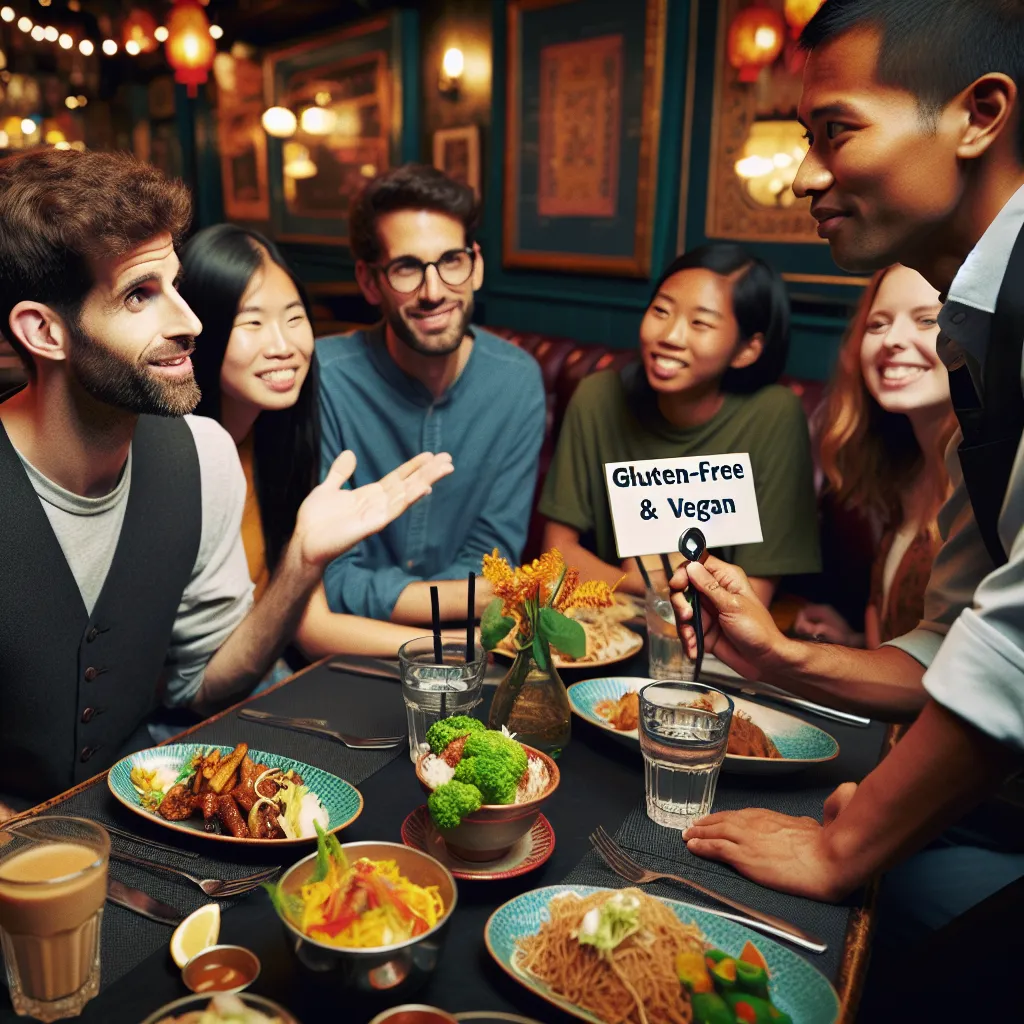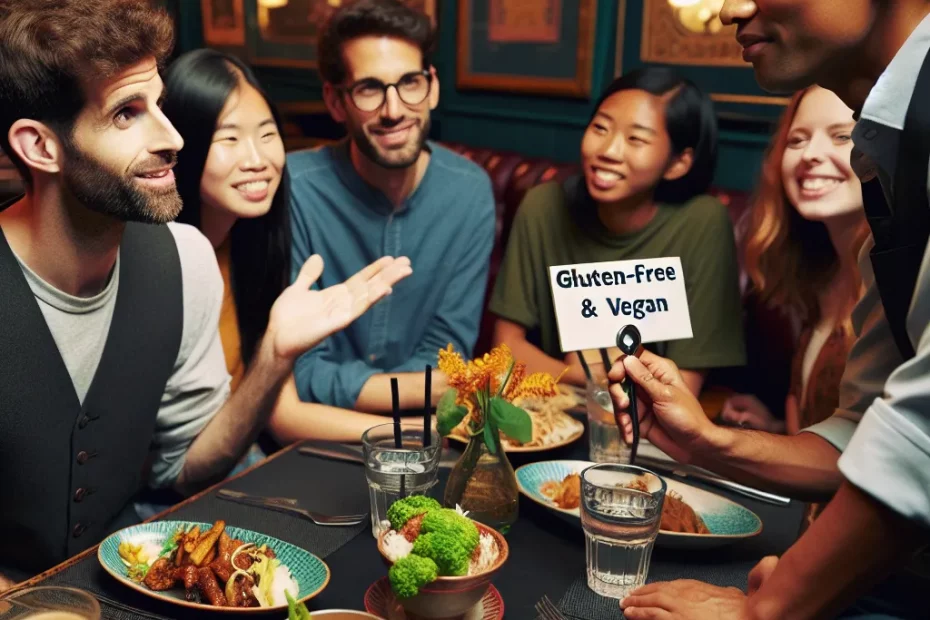Food allergies and dietary restrictions can present challenges when dining out, especially in a foreign country like Korea. Navigating Korean cuisine with these limitations may seem daunting, but with the right knowledge and communication, it is possible to find safe and enjoyable dining options. Whether you’re gluten-free, vegan, or have other dietary needs, understanding how to communicate your requirements in Korean restaurants and exploring alternative dining choices can make your culinary experience in Korea a delightful one. Let’s delve into the world of food allergies and dietary restrictions, and discover how to savor the flavors of Korea without worry.

Understanding Food Allergies and Dietary Restrictions
Hey there, foodies! Today, let’s dive into the world of food allergies and dietary restrictions. Whether you’re dealing with a gluten intolerance, nut allergy, or any other dietary limitation, navigating the culinary landscape can sometimes feel like a daunting task. But fear not, because I’m here to guide you through finding safe dining options in Korea that cater to your specific needs!
Facts about Food Allergies
Did you know that approximately 32 million Americans have food allergies, with 5.6 million of them being children under the age of 18? Food allergies occur when the immune system mistakenly identifies a specific food protein as harmful, triggering a range of symptoms from mild itching to severe anaphylaxis. It’s crucial to take food allergies seriously and always communicate your dietary restrictions clearly when dining out.
Understanding Dietary Restrictions
Now, let’s talk about dietary restrictions. These can stem from various reasons, such as religious beliefs, ethical choices, or health conditions like celiac disease. In Korea, where traditional dishes often contain ingredients like soy sauce (which contains gluten) or gochujang (which may contain traces of nuts), it’s essential to be aware of what you’re consuming to avoid any adverse reactions.
Communication is Key
When dining out in Korea, communication is key. Don’t hesitate to inform your server about your food allergies or dietary restrictions, and ask about the ingredients used in the dishes. Many restaurants in Korea are becoming more accommodating to special dietary needs, offering gluten-free, vegetarian, or even vegan options on their menus.
Stay Safe and Enjoy Your Culinary Adventures
Navigating food allergies and dietary restrictions can be challenging, but with a bit of preparation and awareness, you can still enjoy delicious meals while staying safe and healthy. Remember, your health comes first, so don’t be afraid to speak up and advocate for yourself when it comes to your dietary needs.
So, next time you’re dining out in Korea, arm yourself with knowledge about your food allergies and dietary restrictions, and don’t be afraid to ask questions. Your well-being is worth it, and there are plenty of safe and delicious dining options waiting for you to explore. Stay safe, stay informed, and enjoy your culinary adventures in Korea! 🍽️✨
Navigating Korean Cuisine with Food Allergies
Are you ready to embark on a culinary adventure in Korea but worried about navigating the vibrant food scene with your food allergies or dietary restrictions? Fret not, as I’m here to guide you through the diverse world of Korean cuisine while keeping your health in mind! 🍜🥢
Understanding Korean Dishes and Allergens
Korea is renowned for its rich culinary traditions, from spicy kimchi to savory bulgogi, but it can be challenging to enjoy these delicacies if you have food allergies. As a savvy traveler with dietary restrictions, it’s essential to familiarize yourself with common allergens in Korean dishes. For example, soy sauce, a staple in Korean cooking, often contains wheat, making it a no-go for those with gluten allergies. 🌾❌
Communication is Key
When dining out in Korea, communication is key. Don’t hesitate to inform restaurant staff about your food allergies or dietary requirements. Use simple phrases like “저는 (allergen) 알레르기가 있어요” (I have an allergy to (allergen)) to ensure your meal is prepared safely. Many restaurants in Korea are accommodating and will do their best to customize dishes to suit your needs. 🇰🇷🍽️
Opt for Safe Choices
If you’re unsure about the ingredients used in a particular dish, opt for simple and traditional Korean meals like bibimbap or samgyeopsal (grilled pork belly). These dishes typically consist of rice, vegetables, and protein, making them a safer choice for those with food allergies. Remember, it’s always better to be safe than sorry when exploring a new culinary landscape. 🥗🥩
Be Prepared
For individuals with severe allergies, carrying a food allergy card written in Korean can be a lifesaver. This card lists your allergens in Korean characters, ensuring there are no misunderstandings when communicating your dietary needs. Additionally, familiarize yourself with Korean food labels to identify potential allergens in packaged foods. Your health and well-being should always come first, even when indulging in the flavors of Korea. 🇰🇷🛒
Enjoying Korean Cuisine Safely
In conclusion, navigating Korean cuisine with food allergies may seem daunting at first, but with the right knowledge and preparation, you can savor the tastes of Korea safely. Embrace the culinary delights this vibrant country has to offer while prioritizing your health every step of the way. Bon appétit, or as they say in Korean, “잘 먹겠습니다 (jal meokkesseumnida)!” 🌟🍲
Remember, with a dash of caution and a sprinkle of awareness, you can enjoy a fulfilling gastronomic journey through Korea, one delicious bite at a time! 🌏🍴
Communicating Dietary Needs in Korean Restaurants
Hey there, foodies and travelers! Today, let’s dive into the exciting world of Korean cuisine and how to navigate dietary restrictions and food allergies while dining out in Korea.
Common Dietary Restrictions and Food Allergies
When it comes to communicating your dietary needs in Korean restaurants, it’s essential to be clear and specific. Korean cuisine is known for its rich flavors and diverse ingredients, so it’s crucial to convey your requirements accurately to ensure a safe and enjoyable dining experience.
First things first, let’s talk about common dietary restrictions and food allergies. In Korea, gluten-free (글루텐프리), vegan (비건), and vegetarian (채식주의자) options are becoming more widely available, especially in metropolitan areas like Seoul and Busan. However, it’s still important to communicate your specific needs to the restaurant staff to avoid any misunderstandings.
Effective Communication Tips
When you walk into a Korean restaurant, don’t be afraid to ask questions and seek clarification. Use phrases like “제가 알레르기가 있어서…” (I have allergies to…) or “저는 이 음식을 먹을 수 없어요” (I cannot eat this food) to clearly communicate your dietary restrictions. Korean hospitality is renowned, and most restaurants will do their best to accommodate your needs once they understand them.
If you’re unsure about certain ingredients or dishes, don’t hesitate to ask for assistance. You can say, “이 음식 안에 무슨 재료가 들어있어요?” (What ingredients are in this dish?) or “이 음식에는 어떤 소스가 사용되었나요?” (What sauce is used in this dish?) to get more information about the food preparation.
Remember, communication is key when it comes to ensuring a safe dining experience in Korean restaurants. By being proactive and clear about your dietary needs, you can enjoy the delicious flavors of Korean cuisine without any worries. So, don’t be shy to speak up and let the restaurant staff know how they can help you have a fantastic dining experience.
Happy eating and exploring the vibrant food scene in Korea! 🍜🇰🇷
Exploring Alternative Dining Options in Korea
Are you someone with food allergies or dietary restrictions looking for safe dining options in Korea? Fear not, as Korea offers a variety of alternative dining options to cater to your specific needs! 🌟
Communicating Dietary Requirements
When it comes to food allergies, it’s essential to communicate your dietary requirements clearly to restaurant staff. In Korea, phrases like “저는 ~ 알러지가 있어요” (I have an allergy to ~) or “~를 먹으면 안 돼요” (I can’t eat ~) can be incredibly helpful in ensuring your meal is prepared safely. 🍽️
Gluten-Free Options
For those with gluten intolerance or celiac disease, finding gluten-free options in Korea has become much easier in recent years. Many restaurants now offer gluten-free menus or dishes, and you can also find specialized bakeries and cafes that focus on gluten-free treats. 🥖
Vegetarian and Vegan Choices
Vegetarians and vegans will also find a growing number of restaurants in Korea that cater to their dietary preferences. From traditional Korean temple cuisine to trendy plant-based eateries, there are plenty of delicious options to explore. 🌱
Organic and Locally Sourced Ingredients
If you’re looking for organic and locally sourced ingredients, you’ll be pleased to know that the organic food movement is gaining momentum in Korea. Farmers’ markets, organic grocery stores, and farm-to-table restaurants are becoming more prevalent, making it easier to enjoy fresh and sustainable meals. 🌾
Halal and Kosher Options
And let’s not forget about those who follow halal or kosher dietary laws. While options may be more limited, there are restaurants in Korea that specialize in halal or kosher cuisine, ensuring that you can enjoy a meal that meets your religious dietary requirements. 🕋
So, whether you’re navigating food allergies, dietary restrictions, or simply looking for alternative dining options in Korea, rest assured that there are plenty of choices available to satisfy your cravings while keeping your health and preferences in mind. Bon appétit! 🍜
As you navigate the vibrant culinary scene in Korea with food allergies or dietary restrictions, remember that communication is key. By understanding your needs and effectively conveying them to restaurant staff, you can enjoy safe and delicious dining experiences. Don’t hesitate to ask questions, seek ingredient information, and request modifications to dishes. Additionally, exploring alternative dining options such as vegan restaurants, international cuisine, or health food stores can provide you with more choices. Embrace the adventure of discovering new flavors and cultural dishes while prioritizing your health and well-being. Remember, with a bit of preparation and openness, you can savor the best of Korean cuisine without compromising your dietary needs. Enjoy your culinary journey in Korea!
